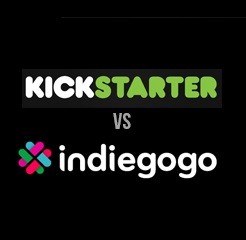Updated May 2, 2018.
As an entrepreneur looking to successfully build a product-based business through crowdfunding, you may be wondering: if Kickstarter has X number of backers and Indiegogo has Y number of users, why not run a campaign simultaneously on both – more backers, more exposure, more overall funding, right?
This is a common misconception, something founders frequently find themselves asking, and is worth looking into. Thinking about running a crowdfunding campaign? Here’s what you need to know!
11 Reasons Simultaneous Kickstarter and Indiegogo Projects are an Awful Idea
1. Multiple campaigns splits your network
Some of your friends and family will back one campaign, while others will back the second campaign.
2. Smaller network means less initial funding from friends and family
With fewer people visiting each campaign page, you’ll have less funding on each page as well.
3. Less early funding = less virality
Without going at least semi-viral and expanding beyond just friends and family contributions, your company can never succeed. For entrepreneurs, crowdfunding provides not only the funding to bring the project to live, but more importantly market validation, a dedicated audience, and product ideas and suggestions, which will ultimately help your company grow and evolve over time.
4. Poor rankings mean less organic backers
In general, the majority of crowdfunding backers browse the most popular pages. These are usually the vetted products with social proof, the coolest projects, and the campaigns most likely to succeed.
To get in on these opportunities and really kickstart your business, you need to be on the popular pages and dominate – which means you need as many backers as possible.
5. Mismatched marketing isn’t effective
Kickstarter success almost always comes down to marketing success, which is largely determined by effort.
You’ll be pitching publications until your fingers tire, your mind fades and you fall asleep at the computer – anything to make it happen. One big blog post, one exclusive or product review, this can make a massive difference in funding and getting that kind of exposure takes effort, brute force effort.
Well, what happens when you split this time and energy between campaigns? You won’t be able to easily pitch both projects to journalists and bloggers, and anyone who finds your story will likely be a bit confused and put off by your disjointed goals.
6. More options makes things confusing
Most of your network wants to help. Ask nicely and a nice portion will do anything within reason to help support your success. Keeping it simple with one campaign makes it easy.
7. Backer bias against being the “other woman”
Crowdfunding gives a typical product launch a more personal touch. Your story and mission are as much a part of your success as your product.
The trust and loyalty a crowdfunding project cultivates with backers can be easily damaged by a multiple-campaign approach. With two options, suddenly backers become just a source of money, rather than a meaningful part of the story and business.
8. More work, less results
Launching campaigns on Kickstarter and Indiegogo at once requires significantly more work than a single platform launch, with a minimal return on the investment of your time.
9. Fulfillment will be a nightmare
One of the biggest and most unexpected hurdles crowdfunders face following a successful Kickstarter or Indiegogo campaign is fulfillment. Between manufacturing mishaps, actually communicating with backers and getting shipments, labels and packaging perfect – fulfillment isn’t easy
With multiple campaigns, fulfillment becomes even more difficult. Suddenly you’re dealing with two different platforms and two different sets of backers.
10. Extra rules and regulations
Indiegogo and Kickstarter are the undisputed champions of crowdfunding. Despite their success though, they are inherently different and competitive.
For you, this means each platform will have different procedures, requirements and gate keepers to work with. Double the work, increased odds of issues and more people potentially able to pull the plug on your project – sound fun?
11. Win-Win or Lose
Finally, the finishing blow, the worse case scenario of dual crowdfunding: What if your Kickstarter collapses but your IGG ignites? Where do you go from there
Final Thoughts
Torn between a Kickstarter campaign and an Indiegogo campaign? Learn more about choosing a crowdfunding platform here.
For more Kickstarter and Indiegogo tips, check out our podcast and subscribe to our newsletter.
Podcast: Play in new window | Download
Subscribe: Apple Podcasts | RSS





[…] Ward’s article, “Can I Run a Kickstarter and an Indiegogo Crowdfunding Campaign at the Same Time,” attacks one of the common questions (and mistakes) that many aggressive entrepreneurs ask and […]
I think you are wrong. Have you ever thought of the counterpoints to this? Have you ever tried both? It all depends on the goals of each campaign and when you launch each campaign. There are a lot of “it depends”. Sheep mentality has kept no one from trying this….
It’s definitely been tried multiple times. It just has never worked that I can tell. The only case that I can find online to suggest otherwise is this one, and it’s kind of sketchy.
http://vabulous.com/10-lessons-learned-from-running-2-back-to-back-crowdfunding-campaigns/
I was staggered to discover that some people had chosen to run simultaneous KS & IGG campaigns. I initially thought this strategy would dilute the power of each campaign and undermine the potential for achieving funding targets.
To my surprise, I learned that a few companies like Luuup had in-fact done so, and appear to have achieved very successful results on both platforms. From my very short review of both campaigns, Luuup ran identical promo videos, imagery and copy – with slight variations between pledge/reward tiers. Makes sense… I’d probably do something similar.
Based on the amount of work it seems to take to prepare and execute a successful crowdfunding campaign on one platform, I suppose one benefit of a simultaneous approach might be if each platform had dedicated and loyal backer community with no cross-over… But I suspect this is not the case.
Another possibility may be to use each platform to offer different reward offerings to trial potential product groupings (kits) or validate other business’ strategies.
Whatever the case, my research suggests it would be a gutsy move for a start-up to run two campaigns given the time & resources it would take to support and manage both in-parallel.
A wise person once said: “Be careful what you wish for, because you just might get it.” To have two wildly successful campaigns sounds awesome on the surface… As long as you can keep everything under control post-campaign!
What if you somehow dedicated, yourself, the exact amount to each campaign that you earned from the other. When you win both campaigns, both achieved the full amount of funding for the project, but about half of each would be your personal donations. Obviously, this means that you’d be in the water the full amount until then though.
What about launching in Indiegogo and a successful Kickstarter campaign? Is it a good idea then?
If you’re referring to Indiegogo InDemand, that’s a great option after a successful Kickstarter campaign! It’s an easy way to keep your momentum going and keep up pre-orders while you get your e-commerce site ready to go.